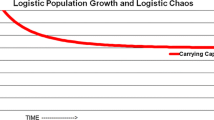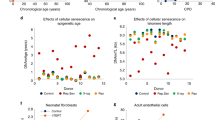Abstract
Animals and plants have biological clocks that help to regulate circadian cycles, seasonal rhythms, growth, development, and sexual maturity. It is reasonable to suspect that the timing of senescence is also influenced by one or more biological clocks. Evolutionary reasoning first articulated by G. Williams suggests that multiple, redundant clocks might influence organismal aging. Some aging clocks that have been proposed include the suprachiasmatic nucleus, the hypothalamus, involution of the thymus, and cellular senescence. Cellular senescence, mediated by telomere attrition, is in a class by itself, having recently been validated as a primary regulator of aging. Gene expression is known to change in characteristic ways with age, and in particular DNA methylation changes in age-related ways. Herein, I propose a new candidate for an aging clock, based on epigenetics and the state of chromosome methylation, particularly in stem cells. If validated, this mechanism would present a challenging target for medical intervention.
Similar content being viewed by others
References
Mitteldorf, J. (2004) Evol. Ecol. Res., 6, 1–17.
Mitteldorf, J. (2010) in Approaches to the Control of Aging: Building a Pathway to Human Life Extension (Fahy, G. M., et al., eds.) Springer, New York.
Mitteldorf, J. (2012) Biochemistry (Moscow), 77, 716–725.
Guarente, L., and Kenyon, C. (2000) Nature, 408, 255–262.
Forbes, V. (2000) Funct. Ecol., 14, 12–24.
Masoro, E. J. (2007) Interdiscipl. Top. Gerontol., 35, 1–17.
Leroi, A., Chippindale, A. K., and Rose, M. R. (1994) Evolution, 48, 1244–1257.
Arantes-Oliveira, N., Berman, J. R., and Kenyon, C. (2003) Science, 302, 611.
Fabrizio, P., Battistella, L., Vardavas, R., Gattazzo, C., Liou, L.-L., Diaspro, A., Dossen, J. W., Gralla, E. B., and Longo, V. D. (2004) J. Cell Biol., 166, 1055–1067.
Clark, W. R. (1998) Sex and the Origins of Death, Oxford University Press, Oxford.
Clark, W. R. (1999) A Means to an End: the Biological Basis of Aging and Death, Oxford University Press, New York.
Clark, W. R. (2004) Adv. Gerontol., 14, 7–20.
Behl, C. (2000) J. Neur. Trans., 107, 1325–1344.
Cawthon, R. M., Smith, K. R., O’Brien, E., Sivatchenko, A., and Kerber, R. A. (2003) Lancet, 361, 393–395.
Williams, G. (1957) Evolution, 11, 398–411.
Mitteldorf, J. (2013) Biochemistry (Moscow), 78, 1054–1060.
Beck, S. D., and Bharadwaj, R. K. (1972) Science, 178, 1210–1211.
Piraino, S., Boero, F., Aeschbach, B., and Schmid, V. (1996) Biol. Bull., 90, 302–312.
Barinaga, M. (1992) Science, 258, 398–399.
Jaskelioff, M., Muller, F. L., Paik, J.-H., Thomas, E., Jiang, S., Adams, A. C., Sahin, E., Kost-Alimova, M., Protopopov, A., Cadicanos, J., Horner, J. W., Maratos-Flier, E., and DePinho, R. A. (2011) Nature, 469, 102–106.
Bernardes de Jesus, B., Vera, E., Schneeberger, K., Tejera, A. M., Ayuso, E., Bosch, F., and Blasco, M. A. (2012) EMBO Mol. Med., 4, 691–704.
Conboy, I. M., Conboy, M. J., Wagers, A. J., Girma, E. R., Weissman, I. L., and Rando, T. A. (2005) Nature, 433, 760–764.
Katcher, H. (2013) Biochemistry (Moscow), 78, 1061–1070.
Bernardes de Jesus, B., Schneeberger, K., Vera, E., Tejera, A., Harley, C. B., and Blasco, M. A. (2011) Aging Cell, 10, 604–621.
Mair, W., Goymer, P., Pletcher, S. D., and Partridge, L. (2003) Science, 301, 1731–1733.
Klein, D. C., Moore, R. Y., and Reppert, S. M. (1991) Suprachiasmatic Nucleus: the Mind’s Clock, Oxford University Press, New York.
Edgar, R. S., Green, E. W., Zhao, Y., van Ooijen, G., Olmedo, M., Qin, X., Xu, Y., Pan, M., Valekunja, U. K., Feeney, K. A., Maywood, E. S., Hastings, M. H., Baliga, N. S., Merrow, M., Millar, A. J., Johnson, C. H., Kyriacou, C. P., O’Neill, J. S., and Reddy, A. B. (2012) Nature, 485, 459–464.
Danks, H. (2005) J. Insect Physiol., 51, 609–619.
Ebling, F. J. (2005) Reproduction, 129, 675–683.
Kumar, S., Mohan, A., and Sharma, V. K. (2005) Chronobiol. Int., 22, 641–653.
Dubrovsky, Y. V., Samsa, W. E., and Kondratov, R. V. (2010) Aging (Albany NY), 2, 936.
Dilman, V. M., and Dean, W. (1992) The Neuroendocrine Theory of Aging and Degenerative Disease, Center for Bio Gerontology.
Weinert, B. T., and Timiras, P. S. (2003) J. Appl. Physiol., 95, 1706–1716.
Walford, R. L. (1964) The Gerontologist, 4, 195–197.
Walford, R. L. (1969) Immunol. Rev., 2, 171.
West, M. D. (2003) The Immortal Cell, Doubleday, New York.
Johnson, A. A., Akman, K., Calimport, S. R., Wuttke, D., Stolzing, A., and de Magalhres, J. P. (2012) Rejuvenation Res., 15, 483–494.
Cooney, C., and Lawren, B. (1999) Methyl Magic: Maximum Health through Methylation, Andrews McNeel Pub.
Jablonka, E., and Raz, G. (2009) The Quart. Rev. Biol., 84, 131–176.
Bellizzi, D., D’Aquila, P., Montesanto, A., Corsonello, A., Mari, V., Mazzei, B., Lattanzio, F., and Passarino, G. (2012) Age, 34, 169–179.
Lin, M.-J., Tang, L. Y., Reddy, M. N., and Shen, C. K. (2005) J. Biol. Chem., 280, 861–864.
Yung, R., Ray, D., Eisenbraun, J. K., Deng, C., Attwood, J., Eisenbraun, M. D., Johnson, K., Miller, R. A., Hanash, S., and Richardson, B. (2001) J. Gerontol. Ser. A: Biol. Sci. Med. Sci., 56, B268–B276.
Ray, D., Wu, A., Wilkinson, J. E., Murphy, H. S., Lu, Q., Kluve-Beckerman, B., Liepnieks, J. J., Benson, M., Yung, R., and Richardson, B. (2006) J. Gerontol. Ser. A: Biol. Sci. Med. Sci., 61, 115–124.
Liu, L., van Groen, T., Kadish, I., Li, Y., Wang, D., James, S. R., Karpf, A. R., and Tollefsbol, T. O. (2011) Clin. Epigenetics, 2, 349–360.
Fraga, M. F., Ballestar, E., Paz, M. F., Ropero, S., Setien, F., Ballestar, M. L., Heine-Sucer, D., Cigudosa, J. C., Urioste, M., Benitez, J., Boix-Chornet, M., Sanchez-Aguilera, A., Ling, C., Carlsson, E., Poulsen, P., Vaag, A., Stephan, Z., Spector, T. D., Wu, Y. Z., Plass, C., and Esteller, M. (2005) Proc. Natl. Acad. Sci. USA, 102, 10604–10609.
Wilson, V. L., and Jones, P. A. (1983) Science (NY), 220, 1055.
Heyn, H., Li, N., Ferreira, H. J., Moran, S., Pisano, D. G., Gomez, A., Diez, J., Sanchez-Mut, J. V., Setien, F., Carmona, F. J., Puca, A. A., Sayols, S., Pujana, M. A., Serra-Musach, J., Iglesias-Platas, I., Formiga, F., Fernandez, A. F., Fraga, M. F., Heath, S. C., Valencia, A., Gut, I. G., Wang, J., and Esteller, M. (2012) Proc. Natl. Acad. Sci. USA, 109, 10522–10527.
Bowles, J. T. (1998) Med. Hypotheses, 51, 179–221.
Vanyushin, B., Nemirovsky, L. E., Klimenko, V. V., Vasiliev, V. K., and Belozersky, A. N. (1973) Gerontology, 19, 138–152.
Wilson, V. L., Smith, R. A., Ma, S., and Culter, R. G. (1987) J. Biol. Chem., 262, 9948–9951.
Mazin, A. (1993) Mol. Biol. (Moscow), 27, 160.
Mazin, A. (1993) Mol. Biol. (Moscow), 27, 895.
Skulachev, V. P. (2004) in Model Systems in Aging (Nystrom, T., and Osiewacz, H. D., eds.) Springer, Berlin, pp. 191–238.
Weitzman, S. A., Turk, P. W., Milkowski, D. H., and Kozlowski, K. (1994) Proc. Natl. Acad. Sci. USA, 91, 1261–1264.
Romanenko, E. B., Alessenko, A. V., and Vanyushin, B. F. (1995) Biochem. Mol. Biol. Int., 35, 87.
Panning, B., and Jaenisch, R. (1996) Genes Devel., 10, 1991–2002.
Kelly, G. (2010) Altern. Med. Rev., 15, 245–263.
Zimmerman, J. A., Malloy, V., Krajcik, R., and Orentreich, N. (2003) Exp. Gerontol., 38, 47.
Baldessarini, R. J. (1987) Am. J. Med., 83 (Suppl. 1), 95–103.
Batra, V., Sridhar, S., and Devasagayam, T. P. A. (2010) Chem.-Biol. Interact., 183, 425–433.
Author information
Authors and Affiliations
Corresponding author
Additional information
Published in Russian in Biokhimiya, 2013, Vol. 78, No. 9, pp. 1337–1344.
Rights and permissions
About this article
Cite this article
Mitteldorf, J.J. How does the body know how old it is? Introducing the epigenetic clock hypothesis. Biochemistry Moscow 78, 1048–1053 (2013). https://doi.org/10.1134/S0006297913090113
Received:
Published:
Issue Date:
DOI: https://doi.org/10.1134/S0006297913090113




